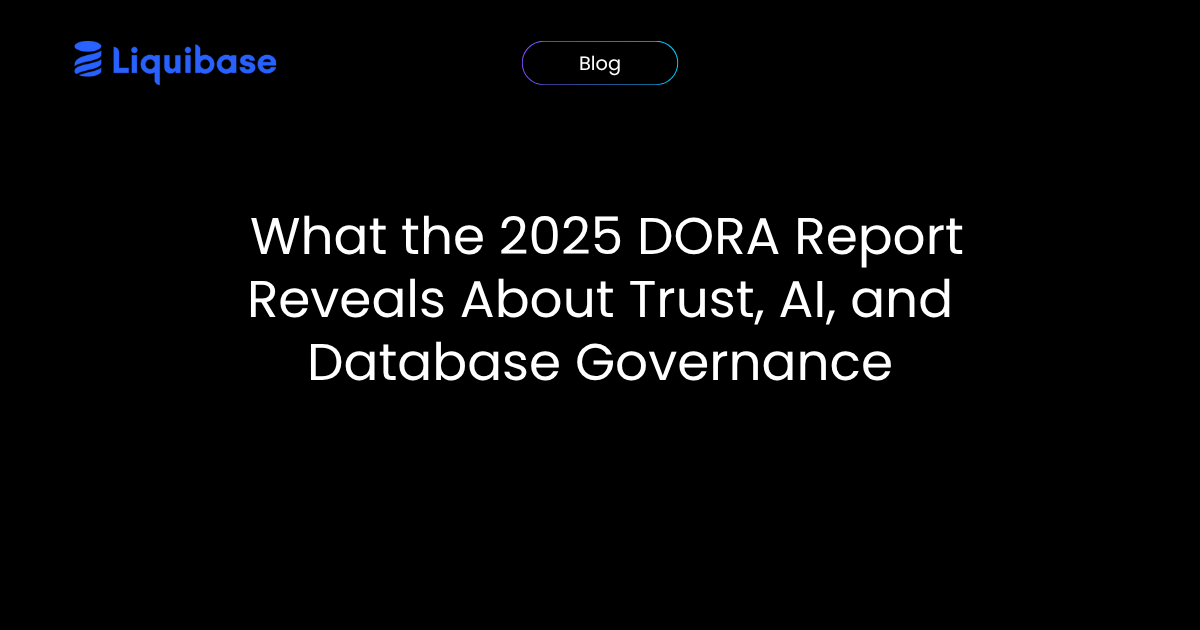Git for the Database: DevOps-Aligned Migrations for Faster, Safer Deployments
June 12, 2024
See Liquibase in Action
Accelerate database changes, reduce failures, and enforce governance across your pipelines.

Content updated September 2025
Key Takeaways
- Git is essential for application code, but many teams still leave databases out of their workflow.
- Database changes without version control often lead to drift, errors, and slow deployments.
- Git for the database makes every schema change traceable, auditable, and easier to automate.
- Liquibase enables GitOps principles for databases, aligning schema changes with DevOps best practices.
Git has transformed how developers collaborate, making it easier to build and release software quickly. Yet, many teams still overlook the database in their standard git workflow.
According to a Liquibase database deployments survey, nearly 60 percent of application releases required changes to the database. As applications and user experiences have become more data-driven, this number has only increased. Data plays a larger role in modern applications, and the need for effective database management is more important than ever.
Still, many development teams leave database changes out of their automated DevOps pipelines. As a result, database deployments are often slow and disconnected from the rest of the process. This can lead to:
- Manual management, review, and testing—raising the risk of errors or security issues
- Poor tracking or no tracking at all—making it difficult to identify who made each change and why
- Lack of versioning—making rollbacks and recovery difficult or impossible
- Inconsistent environments—causing drift, introducing errors, and complicating testing
Liquibase brings git (GitOps) to the database . This means you can version containerized databases, share changes across your team, store versions remotely, and use tags for clear release management.
Let’s look at how this impacts the quality, speed, and reliability of your database schema migrations. To start, it helps to review git as a core DevOps concept and see how it applies to database change management .
What Is Git?
Git is a distributed version control system. It tracks file updates and is widely used across the software industry. Developers rely on git to manage their source code. It allows multiple professionals to work on the same project at the same time without conflicts. Git records all changes and lets teams revert to earlier versions as needed.

Branching and merging in git lets teams work on features in parallel, then combine their work efficiently. Each developer maintains a local copy of the repository, including its entire history. This supports offline work and adds redundancy. Git’s version control tracks progress and helps teams revert to stable states as needed.
The Standard Git Workflow
The typical git workflow is straightforward. A developer runs git init to create a local repository. After making changes, git commit saves a version locally. The developer then uses git push to update a remote branch. Other team members can use git pull to access the latest updates.
Git is essential for modern software development and forms the backbone of many DevOps practices, including continuous integration and continuous deployment (CI/CD).
So why is the database still left out of this process?
What Is Git for the Database?
Git for the database means tracking all changes to databases through files committed to source control, just like application code. This approach brings database version control to database change management , so every change is documented and traceable. Teams can see what was changed, when, and by whom. This transparency supports database integrity and reliability as changes occur.
Another key benefit is automation. Changes can be applied through a DevOps CI/CD pipeline, reducing the need for direct access to sensitive data. This makes deployments faster, more secure, and more consistent across environments. Teams can also roll back changes quickly if needed.
With every change tracked in git, it’s easy to identify who made each update and why. This improves traceability and observability, helping teams resolve issues faster and optimize their processes.
Why High-Performing Teams Use Git for the Database
Bringing git to the database aligns critical data pipelines with modern DevOps practices. It makes database change management a core part of development and deployment.
Version control for database changes ensures every update is tracked, managed, and reversible. Just as teams would never skip versioning for application code, applying git to database workflows ensures consistent management of changes. This supports the integrity and reliability of your data stores.
Using git for the database also improves security and compliance. Automated tracking and policy checks reduce the risk of errors and unauthorized access. With every change recorded, accountability and auditability increase, making it easier to meet data regulations and security requirements.
Git for Databases: Best Practices
To get the most from git for your databases, use these best practices:
- Use tags to manage versioning. For example, create a “golden” database for standardized testing and deployments. Tags help you track and manage specific versions, making updates and rollbacks easier.
- Make small, incremental changes. Shorten the lead time between opening and merging pull requests. Smaller pull requests are usually faster to review and deploy. According to the Linux Foundation (2023), keeping changes between 50 and 100 lines leads to optimal review times. Avoid large, sweeping changes to minimize risk and disruption.
- Choose the right change approach. State-based methods may seem simple, but they can miss critical details and cause conflicts. A migration-based approach bundles small, atomic changes and merges them without disrupting other teams’ work.
- Integrate database change workflows into your CI/CD pipeline. This is essential for realizing the full value of git for database management.
Git vs GitOps
Git is a distributed version control system for tracking code changes and supporting collaboration. GitOps uses git repositories as the single source of truth for managing infrastructure and deployments, automating the process to keep live environments in sync with what’s defined in git. In other words, git manages code, while GitOps automates and manages infrastructure and deployments.
Liquibase enables an automated, migration-based approach to git for the database, bringing GitOps principles to your data workflows.
Liquibase Brings GitOps to Database Change Management
Liquibase goes beyond simple git integration. It brings GitOps automation and control to database change management as part of a unified Database DevOps platform. Liquibase helps teams automate and standardize database changes across more than 60 database platforms. This improves collaboration, consistency, and traceability, connecting the CI/CD pipeline all the way to the database layer.
Liquibase uses a changelog file to define and sequence changes. This changelog can be stored and versioned in git, enabling automated, scripted updates across database environments. This approach maintains the desired state, enhances security and compliance, and supports auditability. If unexpected changes occur, Liquibase can alert your team to investigate database drift .
By aligning database changes with GitOps, Liquibase reduces manual intervention, lowers the risk of errors, and delivers reliable, auditable deployments.
See how you can bring database changes into a GitOps framework with Liquibase.
Frequently Asked Questions
Q1: What does “Git for the database” mean?
It means tracking database schema changes in Git, just like application code, so every update is versioned, documented, and reversible.
Q2: Why should databases be included in Git workflows?
Without Git, database changes can be hard to track, test, and roll back. Git ensures consistency, accountability, and automation across environments.
Q3: How does Git improve database DevOps?
By integrating with CI/CD pipelines, Git streamlines database deployments, improves collaboration, and reduces risk through versioning and automation.
Q4: What’s the difference between Git and GitOps?
Git manages source code and version history. GitOps extends Git by automating deployments and infrastructure management based on the Git repository as the source of truth.
Q5: How does Liquibase support Git for the database?
Liquibase stores database changes as versioned artifacts in Git, integrates with CI/CD, enforces quality checks, and applies GitOps automation to reduce drift and improve reliability.




.png)
.png)

.png)





